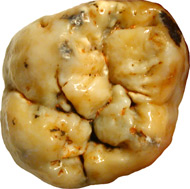
By Ann Gibbons
ScienceNOW Daily News
9 November 2006
With their huge molars and massive jaw muscles, australopithecines have been portrayed as nutcrackers who crunched their way through seeds, nuts, and pulpy fruits. As Africa grew cooler and drier, however, these critical fall-back foods were hard to come by, supposedly leading to the hominid's downfall.
To test this theory, a team of American and British researchers studied the teeth of four individuals of Paranthropus robustus (also known as Australopithecus robustus) from the Swartkrans Cave in South Africa. The team scanned the teeth with a sensitive laser, which did not destroy the teeth but etched them lightly enough to free carbon gases long trapped in the enamel. Because different plants absorb atmospheric carbon dioxide differently, the researchers were able to see what types of vegetation the hominids ate based on the ratio of carbon isotopes in their teeth.
Their cuisine included a mix of tropical grasses and sedges, along with woody fruits, shrubs, and herbs, according to the findings. What's more, carbon samples from ridges laid down like tree rings in a single tooth revealed that the hominids switched between these diverse plants, depending on the time of year. The pattern held, regardless of when the hominids lived. Although the specimens date back to about 1.8 million years ago, each individual's lifetime was probably separated by thousands or tens of thousands of years, indicating that Paranthropus robustus was quite capable of dealing with changes in climate or different habitats. "We didn't expect to see as much variability as we found," says lead author Matt Sponheimer of University of Colorado at Boulder. "It was quite a surprise."
The new method is a huge improvement over old isotopic studies that required anthropologists to drill--and destroy--teeth to sample carbon, like prehistoric dentists, says paleoanthropologist Fred Grine of the Stony Brook University in New York. "Sponheimer's taken the analysis of carbon isotopes in fossils to a new level of sophistication," he says, adding that he hopes that fossil teeth--and diets--of earlier hominids can also be studied with the new nondestructive method.
Fuente: Science: http://sciencenow.sciencemag.org/cgi/content/full/2006/1109/1?etoc

No hay comentarios:
Publicar un comentario